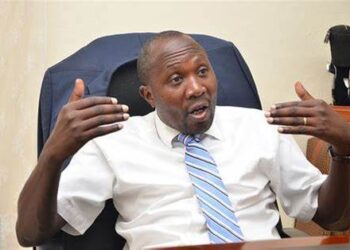By CHIMPREPORTS
Uganda’s debt portfolio is growing at an alarming rate, raising concerns about its sustainability and impact on public service delivery.
According to the State of the Economy report released by Bank of Uganda in December 2023, debts continue to pile a lot of pressure on tax revenues.
“Although recurrent expenditure also underperformed the budget, interest payment overshot the budget by Shs.55.5 billion reflecting high interest rates amid tight financial conditions,” the report seen by ChimpReports reads in part.
“Interest payments and external debt principal repayments exert elevated pressure on tax revenues to the extent that for every 100 shillings collected in tax revenues, 32 goes to debt service, diminishing resources available for service delivery,” the BoU report observed.
Last week, Parliament approved loans worth over Shs 6.868 trillion to fund a supplementary budget; construction of e-government infrastructure and implementation of climate smart agriculture projects.
Uganda has been taking on increasingly large amounts of debt to finance energy, transportation, and other infrastructure, while banking on expected oil revenue to service the debt.
As of August 2023, official Bank of Uganda data indicated that Uganda’s total debt stock stood at UGX88.807tn, marking a 2.8% increase compared to June 2023.
The rise in debt was primarily driven by a 19.1% increase in domestic debt.
Paul Lakuma, a researcher, recently observed that the high cost of debt servicing suggests growing pressures on taxes to finance debt liabilities at the expense of other priority budgetary items, such as education and health.
“While Uganda is not at risk of debt distress, the impact of debt on other sectors cannot be ignored. Notably, domestic debt has contributed to the rise of interest rate, which has limited access to credit to the private sector,” said Lakuma.
“Other impending risks include a rise in the prices of household goods and services.”
Therefore, Uganda risks losing development gains because of debt pressure, the shocks inflicted by the pandemic and associated shocks.
The pandemic also comes at a time when the country is facing climate change-related challenges, impacting production, increasing insecurity in the region, especially in the Democratic Republic of Congo.
While most of the existing stock of external public debt is on concessional terms, the semi- concessional component has been on the rise in recent years.
Lenders
According to the World Bank, highly concessional loans from the IMF, the International Development Association (IDA) and the African Development Fund (ADF) account for half of the external debt portfolio, which mainly drives the difference between the nominal value of public debt and its present value.
Other concessional creditors include the International Fund for Agricultural Development (IFAD), the Arab Bank for Economic Development in Africa (BADEA), the Organization of the Petroleum Exporting Countries (OPEC) fund, and some bilateral Paris and non-Paris club creditors.
The share of semi-concessional and non-concessional debt has been increasing in recent years.
The increase in semi-concessional loans has been driven by official loans from the Export-Import Bank of China, reaching 20 percent of external public debt outstanding at the end of FY 2020/21.
In response to COVID-19, Uganda also resorted to commercial loans that constitute around 8 percent of external public debt, mostly owed to the Trade Development Bank (TDB), Standard Bank of South Africa (SBSA), and Standard Chartered. Finally, the stock of local-currency government securities held by offshore investors increased sharply in FY2020/21, doubling its share in external public debt to 6 percent.








Discussion about this post